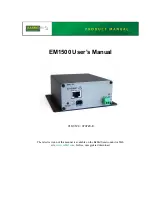
Page 4 of 6
Description of operation
Operating principle of the Accessory Decoder
The Accessory Decoder WDMiba permanently reads the informa-
tion of its dedicated address at the Selectrix-Bus and switches its
dual-port-outputs (one port for position “on”, one port for position
“off”) according to the given bus information.
Depending on the operation mode the outputs are set: For each
output, one of two timers can be assigned. According to the setting
of the timer used, the outputs are powered with pulsed current for
the time specified by the timer, or by continuous current.
Bringing into service
The address of the Accessory Decoder WDMiba, both timers and
the timer assignment for each output are programmed through the
SX bus. In order to do so, a controller, e.g. a central unit ZS1, a
controller unit SPF-PIC or a (bus)-interface with corresponding
computer programme are required.
After plugging Accessory Decoder WDMiba to the SX bus, these
parameters can be set.
During programming of the Accessory Decoder WDMiba the bus
addresses 0 to 3 will be used temporarily. That means during
programming the contents of these addresses will be changed.
Connection of solenoid accessory and light signals
The power supply voltage must be chosen to fit the requirements
of connected accessories:
Turnouts, semaphore signals and uncouplers with coils accept
maximum 16V alternating current. Light signals will need a some-
what lower voltage since the actual output voltage after the
smoothing capacitor of the rectifier circuit is 1.4 times the voltage
of the input alternating current. Light signals equipped with LEDs
designed for 16 V AC should be fed with either 11 V AC or the
value of the LED resistor should be increased respectively.
Output numeration of the Accessory Decoder WDMiba
Connections of output channels
Pin
Tournout
Signal
Uncoupler
a:
Tangent
Stop
Not used
b:
+ VS
+ VS
+ VS
c:
Tournout
Go
Activate
Normal position for turnouts
The usual way is to connect turnouts with their normal position to
be the tangent position. If, however, the main line direction is in
turnout position, the turnout can be wired to the decoder accord-
ingly by swapping wires for turnout and tangent (a and b).
Turnouts wired in tandem
Using maximum two turnout motors wired in tandem is possible
and useful e.g. for hopping tracks. Make sure that the two motors
are identical.
Three-way turnout
A three way turnout
is wired like two
individual
normal
turnouts connected
to two accessory
decoder
output
channels.
Before
switching to turnout
position, the oppo-
site side might have
to be switched to
tangent position.
Light signal
Set the decoder output channel for
continuous current. In order to avoid
too high voltage over signal lamps,
the common terminal (white) can be
alternatively connected to decoder’s
power connector for AC.
Light signal with train affection
Usually a remote control switch (relay) with two changeover
switches is used with light signals for train affection. Remote con-
trol switch is connected to the outputs of a decoder channel. The
switch controls signal lights and track current. Set the decoder
channel to operate in pulsed current mode for remote control
switches with or without end position detectors.
























